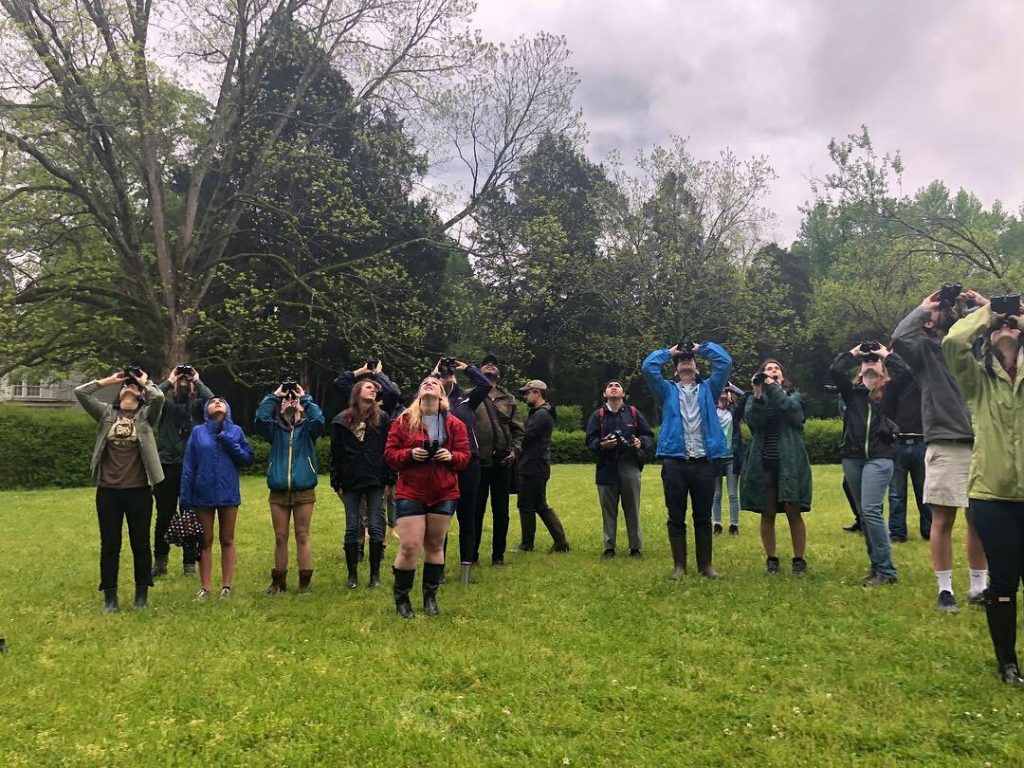
After seniors Rachel Anderson and Emma Counce kept seeing dead birds on the ground when leaving class last fall, they knew something was wrong.
After receiving a $10,000 grant from the National Audubon Society, Counce and Anderson now plan to add stickers to windows on campus buildings to prevent birds dying from window strikes.
Window strikes are a phenomenon where migratory birds — like indigo buntings, warblers and thrushes — look for shelter and food and do not realize they are flying toward building windows. As a result, they fly into the glass, often breaking their necks.
Counce said that since last fall, when she began counting and asking others if they had seen dead birds, she counted between 20 and 25 birds that had died by window strikes. Still, she said there were probably more that were picked up by landscaping and other university personnel.
According to 2018 data from the U.S. Fish and Wildlife Service, it is estimated that 700 million birds die of window strikes each year, making it the second-worst human-caused threat to birds — second only to domesticated cats.
“We were like, ‘Wow, I wonder how often this happens on campus,’” Anderson said. “So we looked it up, and there was an article on Audubon that said skyscrapers aren’t the leading cause of window strikes. It’s smaller buildings that have a bunch of vegetation around them.”
Jason Hoeksema, an associate professor of biology who teaches a course on ornithology, the study of birds, said that window strikes are a “major problem” on the main Oxford campus and at the South Campus Recreation Center. He said that while having many trees on campus gives these birds a habitat to use during migration season, the reflective windows on campus buildings kill up to hundreds of birds each year.
“There’s a place in between Coulter Hall and the Natural Product Center that has an overpass that has reflective glass windows on it, and I used to walk under there every morning and — like clockwork — during spring migration in April, when there are lots of birds migrating North back to their breeding grounds, I would start to find dead birds there,” Hoeksema said.
To combat the number of window strike deaths, Anderson and Counce — with help from Hoeksema and Mitch Robinson at Strawberry Plains Audubon Center, a center for conservation in Holly Springs — devised a plan to prevent more birds from striking windows.
Anderson, the president of student conservation group Magnolia Grove Audubon, applied for the Audubon in Action grant last fall to gather funds for the project. The National Audubon Society gives these grants to local chapters to help them grow their conservations, volunteerism and activism.
The application was accepted, providing $10,000 to Magnolia Grove Audubon to fund marking the windows on the Grove side of Lamar Hall and the sky bridge of Coulter Hall to deter birds from flying toward them. They also applied for a UM Green Fund grant to help with the costs.
By placing small, opaque dots two inches apart all over the windows, birds will realize that the windows are solid objects and avoid them.
In addition to marking the windows, Anderson said the funds will be used to promote diversity within the group and plan recruitment events in Magnolia Grove, including partnerships with Audubon chapters at Rust College and in Starkville.
“Basically, a lot of people that are into birds and conservation are just older white people. So this is a way for them to engage younger people that might have more diversity in age but also in race (and) socioeconomic backgrounds that you would find on a college campus,” Counce said.
Anderson said that even after she and Counce graduate, they want Magnolia Grove to grow and succeed in increasing awareness toward the need for conservation.
“I think (the goal) would be to empower students in Mississippi (and) to spread education about birds and conservation. (I think) a lot of people here don’t really think about Mississippi as a place where we’re very conservation-engaged, but we can be. Mississippi needs more people who care about the environment.”




























